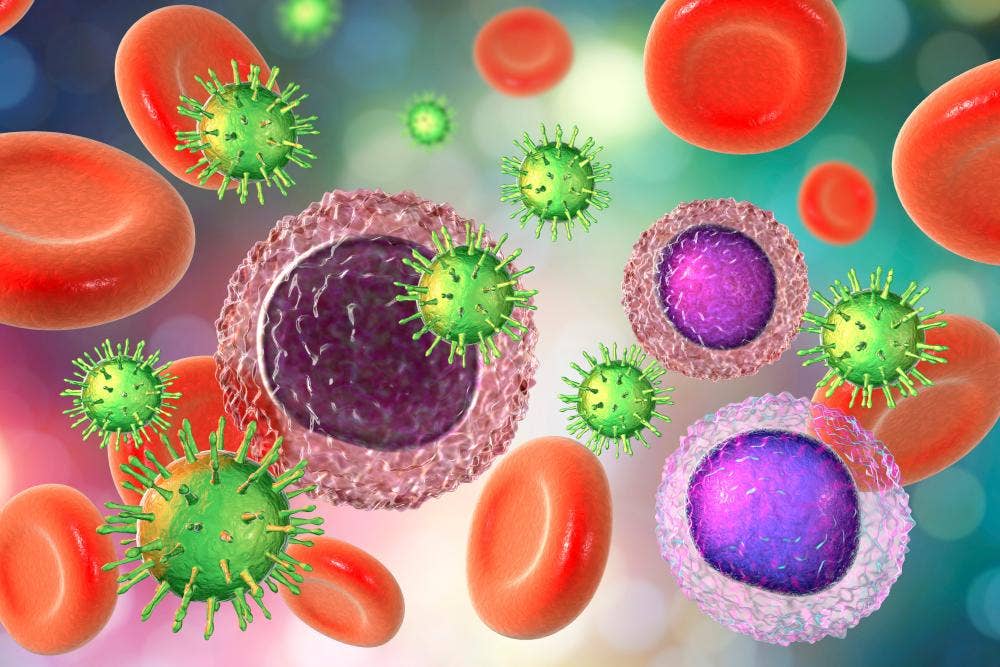Multilayered HIV-1 resistance in HSPCs promises to advance autologous transplant therapy
Allogeneic transplantation of CCR5 null hematopoietic stem and progenitor cells (HSPCs) is the only known cure for HIV-1 infection. However, its utility is limited by a lack of CCR5 null matched donors, the risk of morbidities such as graft versus host disease (GvHD), and the prevalence of HIV-1 strains that do not rely on CCR5 for cellular entry. Although autologous transplantation of cells genetically modified for CCR5 knockout (KO) represents a feasible alternative, it requires further optimization to improve the therapeutic efficacy. To address this need, researchers at Stanford University have developed a method based on simultaneous CCR5 KO and knock-in of multiple HIV-1 inhibiting antibody expression cassettes in human HSPCs. The engineered cells were shown to engraft and reconstitute multiple hematopoietic lineages in immunodeficient mice, while the encoded antibodies maintained their inhibitory function when expressed from B cells in vitro. These findings bring one-time autologous transplant therapy for HIV-1 a step closer.

Strategy for simultaneous CCR5 KO and antibody cassette knock-in in CD34+ HSPCs
CCR5 KO was achieved using a single guide RNA (sgRNA), sg-CCR5, provided by TriLink. This had previously been shown to induce KO INDELs conferring resistance to R5-tropic HIV-1 infection in primary CD4+ T cells. After complexing sg-CCR5 with Cas9, Feist et al. mixed the resultant ribonucleoprotein with human umbilical cord blood-derived CD34+ HSPCs, which were then electroporated and plated in cytokine-supplemented media. Immediately following this step, the cells were treated with rAAV6 vector constructs encoding six well-established HIV-1 antibodies (Ibalizumab, 10-1074, PGDM1400, CAP256V2LS, 3LS, 3BNC117, and 1-18), for knock-in by homology directed repair. Constructs for Ibalizumab and 10-1074 were delivered in combination to demonstrate proof of concept for simultaneous delivery of multiple antibodies.
Characterization of this approach included amplicon deep sequencing of the highest ranked off-target sites, which showed no measurable off-target INDEL formation above the limit of detection. Additionally, knock-in analysis using in-out droplet digital PCR (ddPCR) revealed that each individual antibody construct was incorporated in an average of 31 - 41% of alleles, while dual knock-in of Ibalizumab and 10-1074 was1074 was detected in up to 44% of alleles.
Engineered HSPCs engraft and reconstitute multiple hematopoietic lineages in vivo
CD34+ HSPCs edited with Ibalizumab, 10-1074, or both, were tested to confirm similar frequencies of CCR5 KO INDEL formation and antibody knock-in before being transplanted into sub-lethally irradiated immunodeficient NSG mice. Flow cytometry analysis of human and mouse markers showed successful engraftment in the bone marrow and migration to the spleen, with each editing condition producing comparable frequencies of CD19+ B lineage cells and CD33+ myeloid lineage cells. Importantly, the CD19+ cells maintained knock-in alleles, indicating that integration of the antibody cassettes does not dramatically inhibit early B cell formation. To increase the frequency of integrated alleles at the engraftment endpoint, Feist et al. subsequently augmented the knock-in protocol with AZD7648 treatment prior to transplantation.
B cell progeny secretes functional levels of HIV-1 inhibiting antibodies
Due to limitations in the humanized mouse model, it was not possible to determine whether the B cells derived from engineered HSPCs produced therapeutically relevant concentrations of antibodies in vivo. To account for this, Feist et al. edited adult peripheral blood CD19+ B cells at the CCR5 locus with an analogous method to that used for HSPCs and assessed antibody expression and function. ddPCR revealed knock-in at the CCR5 locus with frequencies up to 43% of alleles, while antigen-specific ELISA analysis of cell culture supernatants confirmed the presence of each antibody. In addition, testing serial dilutions of cell culture supernatants for neutralization potency (TZM-bl infection assay) against two HIV-1 pseudoviruses (TRO11 and CNE55) showed the edited B cells to effectively secrete inhibitory concentrations of antibodies. It was also found that deficiencies of any single antibody could be overcome by expressing combinations of antibodies.
Conclusion
Ex vivo genetic engineering of autologous HSPCs to achieve both CCR5 KO and secretion of HIV-1 inhibiting antibodies from B cell progeny represents an important step toward a potential one-time functional cure for HIV-1. Furthermore, knock-in of alternate antibodies into the CCR5 safe harbor site could have utility for treating other chronic diseases that require long-term dosing of monoclonal antibodies.
Featured products: CRISPR guide RNA (gRNA/sgRNA)
Related products: Genome eEditing mRNA, Oligonucleotide synthesis services
Article reference: Feist WN, Luna SE, Ben-Efraim K. et al. Multilayered HIV-1 resistance in HSPCs through CCR5 Knockout and B cell secretion of HIV-inhibiting antibodies. Nat Commun 16, 3103 (2025). https://www.nature.com/articles/s41467-025-58371-8


